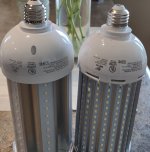ptonsparky
Tom
- Occupation
- EC - retired
Obviously the life expectancy is considerably less than expected. The two year old unit on the right failed a month or so ago. Portions at a time. Odd for what I expected as a driver failure. Thinking now it was the circuit board assembly that fed the LED strips. I'll verify today, maybe.
Both units have the same catalogue #. Light distribution is different if you look at the shadows cast on the ceiling but once away from that, I see no difference. Subjective.
Have they improved the LED that much in two years or are they driving them harder?
Both units have the same catalogue #. Light distribution is different if you look at the shadows cast on the ceiling but once away from that, I see no difference. Subjective.
Have they improved the LED that much in two years or are they driving them harder?


